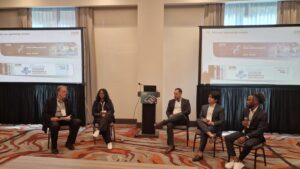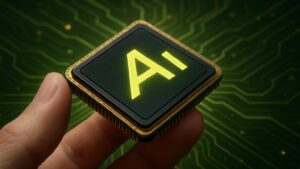The age of next-generation semiconductor manufacturing is here, but High-NA EUV is not a simple progression; it’s an economic/ strategic inflection point. Though our industry is built on the ability to overcome scaling challenges, going to High-NA EUV is a financial & infrastructural cliff. The investment at stake is so enormous, mandating a complete overhaul of facility planning. It also mandates an overhaul of utility infrastructure and capital planning. This vaults well above a typical CapEx choice into a “bet the company” strategic action. This technology is creating a historically unprecedented competitive moat. It raises the barrier to entry so high that it might limit widespread competition to the bleeding edge. This article explores the deep technical, economic, and ecosystem-wide implications of this revolutionary new technology.
The Physics of Exclusion: How High-NA EUV Creates an Insurmountable Technical Barrier
The step to High-NA EUV stretches the frontiers of applied physics and materials science to the ultimate extent. Furthermore, the challenges are so fundamental that they form a barrier not to capital, but to intrinsic scientific and engineering ability. This section will delve into the particular technical challenges from photon physics to new chemistry that constitute the first, most difficult tier of the moat:
The Wavelength & Resist Challenge: The Fundamental Hurdle on the Road to EUV
The transition to the 13.5nm wavelength for EUV lithography forms an enormous physics challenge referred to as the RLS tradeoff. It is a contest between Resolution, Line Edge Roughness, and Sensitivity. In order to solve the features required for a sub-10nm metal pitch, engineers require a low photon dose on the resist. Moreover, this lack of photons induces quantum “shot noise,” erratic fluctuations. These appear as a 1-2nm physical roughness on an inked line. Furthermore, for a contemporary Gate-All-Around transistor, this roughness is disastrous. It generates current leakage paths that ruin a chip’s power efficiency and yield. A 1% decrease in yield on a high-end processor wafer translates to tens of millions of dollars in lost sales per month. This is one of the key challenges of extreme ultraviolet patterning.
The Metal Oxide Resist Revolution: A Materials Science Arms Race
Traditional chemically amplified resists are no longer adequate for the size of current EUV lithography. The reason for this is that their use of acid diffusion to generate a pattern necessarily introduces blurriness on scales less than 10nm. This created a worldwide competition to master metal oxide resist (MOR) platforms. Additionally, a metal oxide resist, such as those created by Inpria, employs inorganic tin-oxo clusters, which possess a much larger photon capture cross-section. They capture EUV photons and undergo chemical alteration without diffusion, resulting in a very sharp pattern on the wafer. But doing so accurately and without defects is a multi-billion-dollar R&D problem. This makes the EUV photoresist itself a huge materials science moat.
Stochastic Effects: The Unseen Enemy of High-Volume EUV Patterning
At the atomic scale, stochastic effects: random/unforeseen errors, are the nemesis of high-yield semiconductor manufacturing. Furthermore, a single “stochastic printing defect,” such as a lost contact point in one of the billions of vias on an advanced AI accelerator chip, can make the whole multi-thousand-dollar chip useless. The general problem of high-volume manufacturing is maintaining the likelihood of this occurring from 1-in-a-million to 1-in-a-trillion. Moreover, this involves modeling petabytes of past production data in order to forecast and avoid these random defects. This also makes learning to overcome the challenges of extreme ultraviolet patterning an operational moat that new entrants, lacking the data, simply cannot breach.
The Pellicle Paradox: A Single Point of Failure for High-NA EUV
A pellicle shields the irreplaceable photomask, or reticle, from dust. For High-NA EUV systems, whose power sources on the roadmap have to be more than 600W, this is a materials science nightmare. Furthermore, a standard polysilicon pellicle would suffer thermal runaway and disaster in a matter of minutes at such a power level. As explained in detail at conferences, the industry is investigating new, free-standing carbon nanotube (CNT) membranes. But it is an enormous R&D challenge to produce a defect-free CNT pellicle on a large scale. Additionally, this makes what appears to be a straightforward component into a key, underappreciated element of the High-NA EUV moat, as only a few can sponsor this research.
The Economics of Dominance: Analyzing the Financial Architecture of the High-NA EUV Moat
In addition to the physics, High-NA EUV’s financial structure also builds a castle of its own. The magnitude of investment and singular business models at play are remodeling the economics for every chipmaker. So, here we will examine the staggering costs, the strategic bets, and the monopolistic forces that build an economic moat as strong as the technical one:
ASML’s Strategic Monopoly: More Than a Supplier, a Kingmaker
ASML works more like a strategic kingmaker and less like a supplier by way of initiatives. It includes its High-NA Executive Co-Investment Program. Under the program, customers invested more than a billion dollars in R&D funding just to have access to the new equipment first. Furthermore, this is not a typical customer relationship; it’s a strategic partnership where money buys access. With a limited production cycle for its EUV system, ASML essentially controls which chipmakers, such as TSMC, drive the next generation. Such ecosystem control also enhances the High-NA EUV competitive edge of its selected partners.
The Billion-Dollar Fab Upgrade: The Hidden Costs Beyond the Scanner
The actual cost of a next-gen fab build in USA is huge, and the scanner is merely the beginning. A High-NA EUV fab requires a power envelope of over 150 megawatts, enough for a small city. Moreover, the cost of the specialized sub-fab, the utility infrastructure, and the massive cleanroom bays can now account for up to 50% of the total project budget. This is a huge increase from previous nodes. These extra costs overshadow the cost of the machine. It also creates an enormous financial moat that only the very best-capitalized players can breach.
Intel’s High-NA EUV Bet: A Case Study on the Economics of Being First
Intel’s bet on High-NA EUV is a calculated risk to overtake rivals at its next A14 (1.4nm) node. Whereas others will employ elaborate, double-patterning methods with current 0.33 NA equipment, Intel plans to go straight to a more straightforward, single-patterning method with its new ASML EXE:5200 equipment. The bet is that the huge initial investment expense will be outweighed by higher yields/lower capital expense. This is to operate than the flawed double-patterning method. Additionally, the most significant risk is ecosystem maturity. This means if the pellicle and photoresist technology is not ready for high-volume production promptly, their multi-billion-dollar asset sits idle. If it succeeds, it is an enormous High-NA EUV competitive advantage. This is what true revolutionaries look like.
The End of the Fabless Dream for the Leading Edge?
The emergence of High-NA EUV has a dramatic effect on fabless companies. Having only two or three such foundries on the entire globe that can manufacture chips on the most advanced nodes, the foundry now has all the power. Moreover, fabless firms do not command as much leverage as they used to. This de facto ends the “level playing field” for the best EUV technology. A smaller fabless disruptor may have to queue up for manufacturing capacity behind a behemoth like Apple or Nvidia and lose the all-important time-to-market window. It is necessary for survival in today’s high-speed world of semiconductor production.
The Ecosystem Consolidation: How the Moat Reshapes the Entire Semiconductor Landscape
This level of technological disruption does not occur in isolation; it ripples across the entire supply chain of the world. Concentration at the top compels a restructuring of the entire ecosystem, from the pipeline of talent to material providers. This section looks at the implications of the moat, outlining how it affects the workforce, the supply chain, and the market structure itself:
The Talent Vacuum: How a Few Giants Are Absorbing the World’s EUV Experts
The few firms that are putting money into high-NA EUV lithography are methodically recruiting the world’s leading plasma-light-interaction-experienced physicists and stochastic effects modelable engineers. Additionally, they hire directly from the best research universities, such as IMEC. This robs the rest of the industry of the brainpower to innovate. This human capital moat is perhaps the most formidable barrier to hurdle. The brightest talent also stays focused in a handful of places. As a result, this keeps new entrants from even beginning.
The Material Science Squeeze: Consolidating the EUV Photoresist Supply Chain
The supply chain for the key EUV photoresist is also narrowing down. The technical intricacies of the metal oxide resist make it possible for only select chemical firms, such as JSR Corporation and FujiFilm, to compete with the multi-billion-dollar R&D investment and the extensive expertise necessary. Moreover, this limits options and raises dependence for all chipmakers that require access to these cutting-edge materials. When only two or three suppliers can reliably provide a metal oxide resist, they possess enormous price power. This further increases the already stratospheric cost of building a next-generation fab in USA.
The Data Moat: The Unassailable Advantage of High-Volume EUV Patterning
A frequently neglected advantage is data. A foundry producing 100,000 wafers per month on an EUV process produces petabytes of metrology data. This information, including spectral information from inspection equipment and chemical concentration information from sensors, is input into a “digital twin” of the process. Furthermore, this enables them to simulate how a slight temperature variation at a microscopic level in a bake chamber will impact the resulting transistor performance. So, this is an optimization that a new entrant simply cannot do without that prior history of data.
The “Road to EUV” Becomes a Private Toll Road
The industry-wide, collaborative “road to EUV” of the past, with its common research and consortia such as SEMATECH, is now a private, toll-high road. It is controlled by an elite few. The “level playing field” is no more because access to the key building blocks of next-generation EUV technology is now controlled. These include physics, optics, tools, materials, and talent. Additionally, the tremendous investment involved in High-NA EUV ensures that innovation on the leading edge is no longer a democratic process; it’s an exclusive privilege afforded to those who are willing & can afford the price.
To Wrap Up: Navigating the New Semiconductor Landscape
High-NA EUV isn’t just an impressive piece of engineering; it’s shaking up the semiconductor industry & changing how everything is built. It’s accelerating the transition from a competitive marketplace to a high-tech oligopoly where the cost of entry is calculated in billions. The survival/ growth strategy is to adjust by emphasizing the specialized nodes, leading-edge packaging, or new materials. These are elements on which a new type of competitive advantage can be constructed. Making these high-risk choices calls for the most current industry data and peer-to-peer insights. Learn more about these challenges/more insightful strategies & trends by attending the 4th Semiconductor Fab Design & Construction Summit in Dallas, TX, on 5-6 November 2025 with other industry peers. Learn more!


